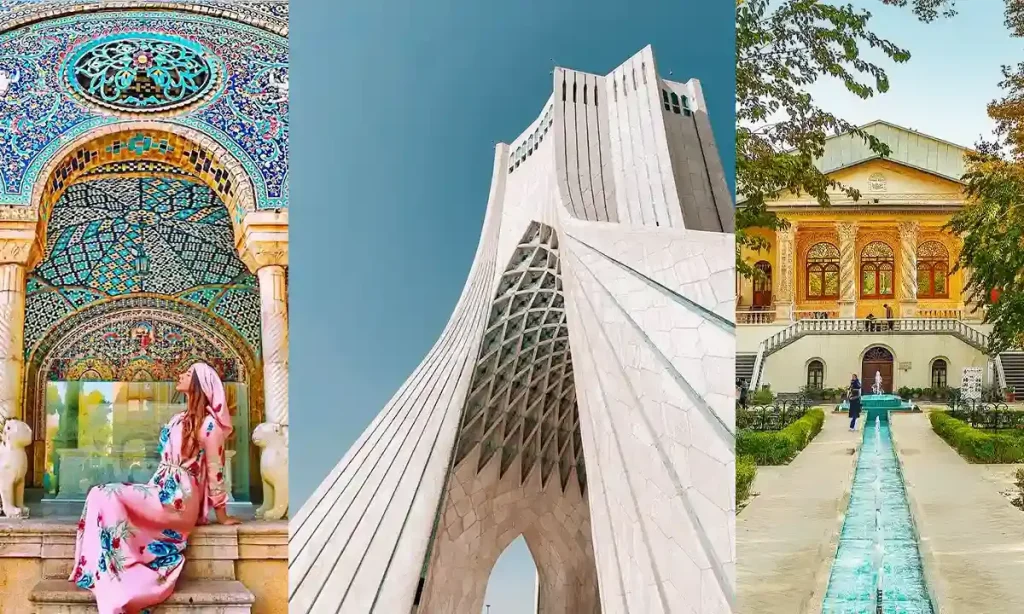Delve into the heart of Iran with a tour of Tehran’s cultural attractions. From the majestic Azadi Tower to the historic treasures housed in the National Museum of Iran, the city offers a captivating mix of tradition and modernity. Discover the best places to immerse yourself in Tehran’s rich history and vibrant cultural scene, where each visit offers a deep insight into the nation’s heritage.
What are the best Cultural attractions of Tehran?
- Golestan Palace
- National Museum of Iran
- Tehran Museum of Contemporary Art
- Azadi Tower
- Sa’dabad Complex
- Treasury of National Jewels
- Milad Tower
- Carpet Museum of Iran
- Tabiat Bridge
- Tehran Grand Bazaar
- Tehran Museum of Contemporary Art
- Darband
- City Theater
- Cinema Museum of Iran
- Artists Park
- Carpet Museum of Iran
- Iranian Artists Forum
The most important historical places of Tehran
The most important historical places of Tehran encompass a diverse array of sites, each representing significant aspects of Iran’s rich cultural and political heritage. These sites include majestic palaces that showcase the opulence of past dynasties, museums that house invaluable artifacts spanning millennia, and religious structures that reflect the spiritual and architectural ingenuity of the region. Together, they provide a comprehensive glimpse into the historical tapestry of Tehran, illustrating its evolution from a modest town to the bustling metropolis and capital it is today. Each site not only preserves unique elements of Iranian history but also offers insights into the social and political shifts that have shaped the nation.
Top Tourist Spots and Historical Sites in Tehran
- Golestan Palace
Golestan Palace in Tehran stands as a significant testament to the lavish lifestyle and architectural evolution during the Qajar era. Declared a UNESCO World Heritage site, this palace complex is among the oldest in Tehran, with its origins dating back to the 18th century, though major constructions and renovations occurred under the rule of Nasser al-Din Shah in the 19th century.
Here are some key aspects of Golestan Palace that make it a must-visit:
- Architecture and Design: The palace showcases a unique blend of Persian craftsmanship with Western influences, evident in its mirrored halls, intricate tile work, and ornate ceilings. The architecture is a fascinating study of the cross-cultural exchanges of the Qajar period.
- Royal Setting and Gardens: Surrounded by lush gardens and courtyards, the palace environment offers a serene escape from the bustling city. The gardens are well-maintained and provide a beautiful example of Persian garden design.
- Historical Significance: The palace served as the royal residence and the seat of power for the Qajar kings and was the site of significant historical events, including the coronation of several Qajar and Pahlavi monarchs.
- Museums and Halls: The complex includes several museums that were formerly the palace’s grand halls. Notable among them is the Marble Throne Hall, used for coronations and important ceremonies. The halls are filled with an array of artifacts, royal clothing, and art, giving visitors insight into the era’s culture and the opulent lifestyle of the royal family.
- Photography and Art: For those interested in photography and art, the palace offers stunning visuals and intricate artworks, including paintings, mosaics, and mirrored walls, which are perfect for those looking to capture the essence of Persian artistic heritage.
Visiting Golestan Palace provides a comprehensive glimpse into Iran’s royal past and artistic traditions, making it an essential destination for anyone interested in history, architecture, and Persian culture.
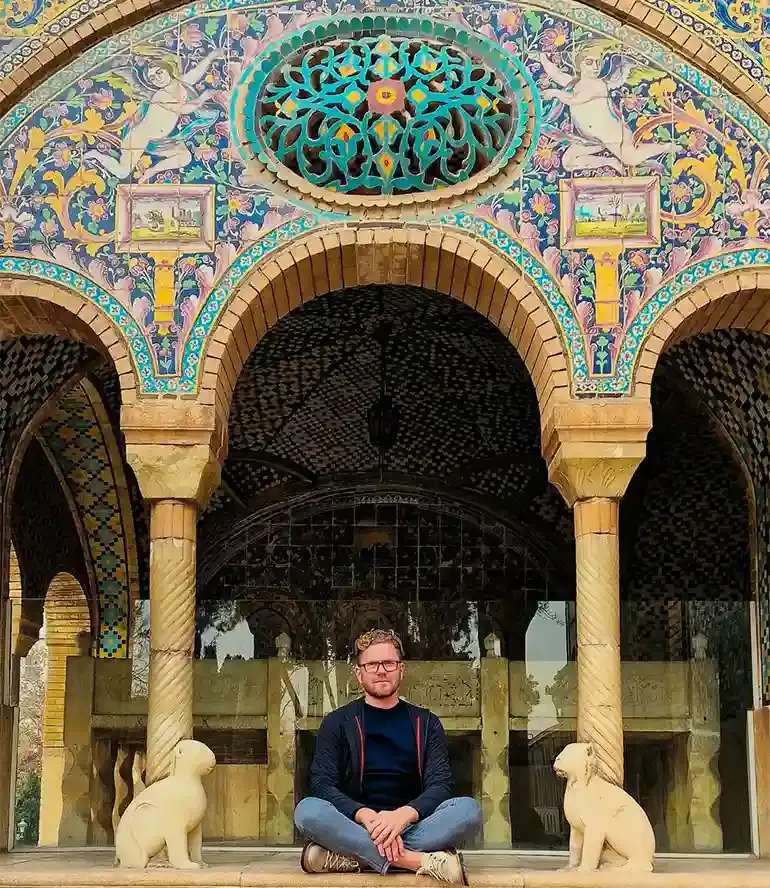
- National Museum of Iran
The National Museum of Iran, located in Tehran, is a crucial repository of Persian history and culture, encapsulating thousands of years of the region’s heritage. This museum is divided into two main buildings: the Museum of Ancient Iran and the Museum of the Islamic Era, providing a comprehensive overview from prehistoric times to the contemporary period.
- Ancient Artifacts: The Museum of Ancient Iran houses an impressive collection that includes pottery, metal works, and stone figures from Iran’s earliest dwellers to the end of the Sassanian Empire, which fell to the Arabs in the 7th century AD.
- Historical Coverage: The museum’s exhibits trace the chronological history of Iran, showcasing items from major periods such as the Elamite, Median, Achaemenid, Seleucid, Parthian, and Sassanian dynasties. This extensive collection helps illustrate the development of civilization in this region.
- Islamic Art and Artifacts: The Museum of the Islamic Era features artifacts from the advent of Islam in Iran up to the modern era. Here, visitors can explore a variety of Islamic art forms, including calligraphy, textiles, ceramics, and manuscripts, highlighting the artistic and cultural transformations influenced by Islam.
- Architectural Significance: The building itself is noted for its architecture, inspired by Sassanian vaults and arches, providing a fitting ambiance for the ancient collections housed within.
- Educational Programs and Research: The museum is not only a tourist attraction but also a center for archaeological research and education, offering various programs, workshops, and publications that delve into Iran’s historical and cultural complexities.
- Special Exhibits: The museum frequently hosts special exhibits that focus on specific aspects of Iranian culture or temporary exhibitions of items from other countries, providing visitors with continually updated and engaging content.
Visiting the National Museum of Iran offers invaluable insight into the vast and varied history of Iran, from ancient civilizations through to the Islamic era, making it a pivotal experience for those looking to understand the historical and cultural evolution of this region.
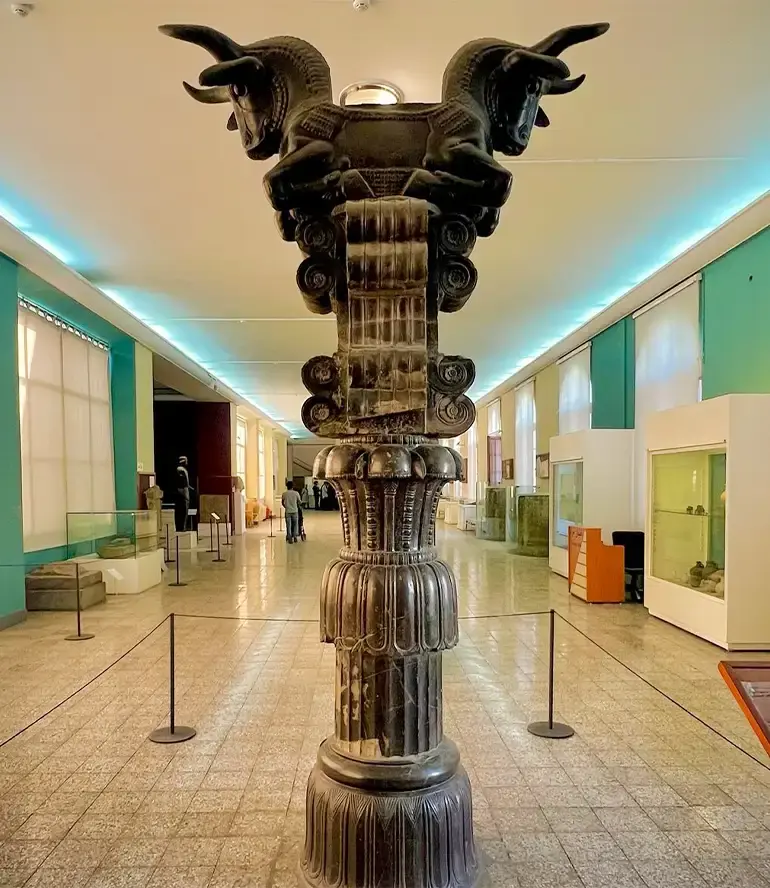
- Niavaran Palace Complex
The Niavaran Palace Complex, situated in the northern part of Tehran, is a historic site that served as the last royal residence of the Shah of Iran before the 1979 revolution. This complex not only offers a glimpse into the luxurious lifestyle of the Pahlavi dynasty but also serves as a cultural and historical repository, showcasing fine art, royal artifacts, and architectural excellence.
- Diverse Buildings: The complex includes several buildings, each serving different purposes during the royal tenure. The main Niavaran Palace, built in the 1960s, is noted for its modern architectural style and was the primary residence of Mohammad Reza Pahlavi and his family. Other significant structures include the Sahebqraniyeh Palace, which dates back to the Qajar era and features classic Persian and European decor, and the Ahmad Shahi Pavilion, which served as the summer residence for Ahmad Shah Qajar.
- Museum Exhibitions: The palaces have been converted into museums, each housing an array of artifacts that depict the opulence of royal life. These include royal garments, gifts received from foreign dignitaries, art collections, and personal items belonging to the royal family.
- Art and Culture: The Niavaran Palace Complex is home to several cultural institutions, including a dedicated library, a music institute, and galleries that host exhibitions of contemporary Iranian art. The complex is a hub for cultural events and activities that attract artists and cultural enthusiasts from around the globe.
- Gardens and Surroundings: Enclosed within beautifully landscaped gardens, the complex offers a serene environment that contrasts with the bustling urban landscape of Tehran. The gardens are well-maintained and provide a peaceful retreat for visitors.
- Historical Significance: Beyond its architectural and artistic value, the Niavaran Palace Complex holds historical significance as the backdrop for many pivotal moments in the late 20th-century history of Iran, including meetings and decisions leading up to the 1979 revolution.
Visiting the Niavaran Palace Complex provides a comprehensive look at Iran’s royal past as well as its cultural progression, offering insights into both the historical and contemporary lifestyle of Iranian royalty.
- Tehran Grand Bazaar
The Tehran Grand Bazaar is a sprawling marketplace that lies at the heart of Tehran’s economic and social life, embodying the bustling, vibrant spirit of the city. This historic bazaar is not only a hub for buying and selling goods but also a place rich in culture and history, offering a fascinating glimpse into everyday Iranian life.
- Size and Structure: The bazaar covers several kilometers and includes countless corridors and lanes, each specializing in different types of goods. From carpets, spices, and jewelry to clothing and household items, the bazaar seems to stretch endlessly, with each section offering a discovery.
- Historical Significance: With origins that date back to the Safavid era in the 16th century, the bazaar has grown and evolved over centuries. It played a significant role in the political developments of Iran, especially during the 1979 revolution, serving as a meeting point for pro-revolutionary groups.
- Cultural Hub: The bazaar is not just about commerce; it is also a cultural center where you can experience the traditional Iranian way of life. It’s common to see groups of people engaging in long conversations over tea, negotiating deals, or exchanging news.
- Architectural Aspects: The architecture of the bazaar is a testament to various periods in Iranian history, showcasing intricate tile work, beautiful domes, and classic Persian design elements. The structure is designed to keep the interior cool, making it comfortable to shop even during the hot Tehran summers.
- Food and Gastronomy: The bazaar is also a fantastic place to explore Persian cuisine, with numerous food stalls and traditional tea houses scattered throughout the area. Here, visitors can try a variety of regional snacks and dishes, such as kebabs, saffron-flavored ice creams, and the famous Persian tea.
- Shopping Experience: Shopping in the Tehran Grand Bazaar offers much more than the mere exchange of goods. It’s an experience that involves bargaining, tasting local delicacies, and interacting with locals, providing a deep dive into Iranian culture and commerce.
Visiting the Tehran Grand Bazaar offers an immersive experience of Iran’s rich history and vibrant contemporary culture, making it a must-visit destination for those looking to understand the essence of Tehran.
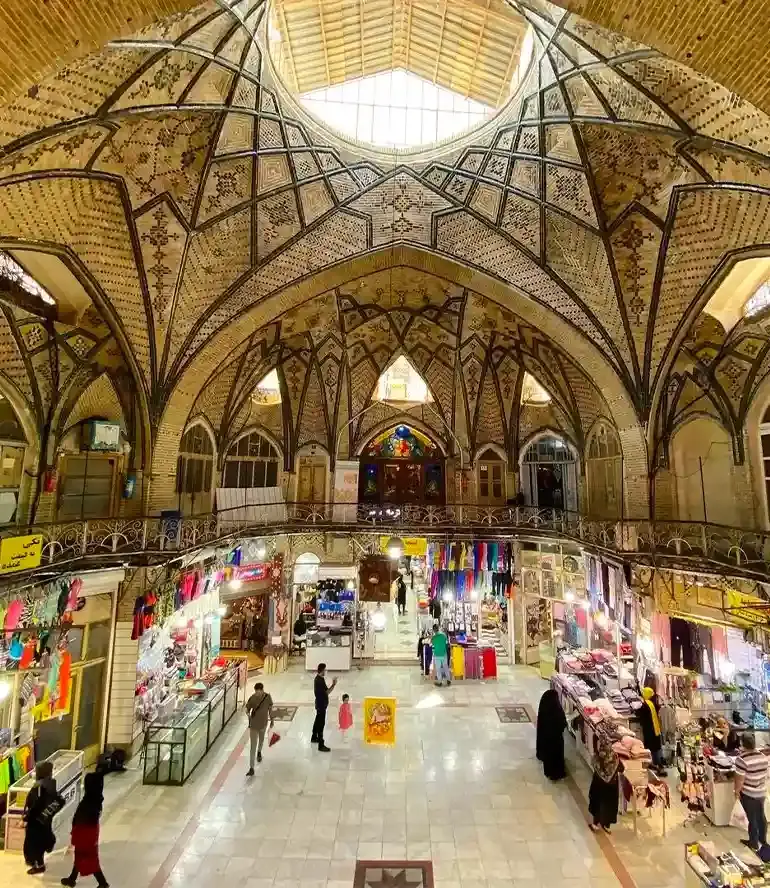
- Azadi Tower
The Azadi Tower, formerly known as the Shahyad Tower, stands as one of Tehran’s most iconic landmarks. It was completed in 1971 to commemorate the 2,500th anniversary of the Persian Empire, and it symbolizes both the ancient history and modern aspirations of Iran.
- Architectural Significance: The tower was designed by Iranian architect Hossein Amanat and combines elements of both pre-Islamic and Islamic architectural styles. The structure is shaped like an inverted Y, supported by four massive columns. The exterior is covered in over 8,000 white marble stones, quarried in the Esfahan region, reflecting traditional Persian architecture.
- Cultural Symbol: The Azadi Tower has become a symbol of Tehran and Iran, representing a gateway to the country. It has witnessed many significant historical events and has been a focal point for political and social gatherings.
- Museum: Beneath the tower, there is a museum that was originally a part of the tower’s foundation. The museum displays artifacts from various periods of Iranian history, including pottery, old coins, and tools, giving visitors insights into the rich cultural heritage of the region.
- Location and Accessibility: Positioned at the western entrance to Tehran, the tower is strategically located at a busy traffic intersection and can be seen from various parts of the city. It is easily accessible for tourists and provides a panoramic view of Tehran from the top.
- Lighting and Events: The tower is particularly striking at night when it is illuminated by various lights, enhancing its architectural features. It also serves as a venue for many national events and celebrations, including fireworks during national holidays.
Visiting the Azadi Tower offers not only a chance to appreciate its impressive architecture but also to engage with a significant cultural and historical symbol of Iran, making it a pivotal experience for anyone exploring Tehran.
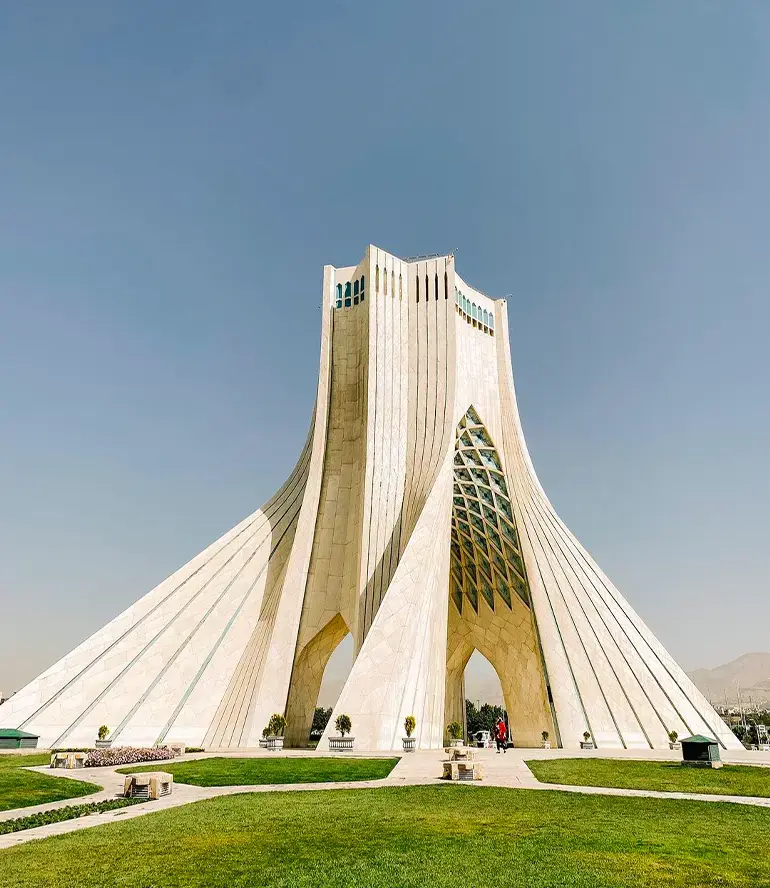
- Milad Tower
The Milad Tower, also known as the Tehran Tower, is a prominent feature of Tehran’s skyline and is the sixth-tallest tower in the world. Completed in 2007, it serves as both a telecommunications antenna and a tourist attraction, offering panoramic views of the city and a variety of recreational facilities.
- Architectural Features: Standing at approximately 435 meters (1,427 feet) tall, including the antenna, Milad Tower is the tallest structure in Iran. Its design includes a large pod at the top, which consists of 12 floors. The tower’s base is a complex containing a public art gallery, a museum, and various cafes and restaurants.
- Observation Deck: One of the major attractions of the Milad Tower is its observation deck, which provides a 360-degree view of the entire Tehran area. The deck is a popular spot for both locals and tourists who want to see the city from above.
- Revolving Restaurant: The tower features a revolving restaurant at one of the highest levels, offering diners a constantly changing vista as they enjoy a meal. This restaurant is a draw for its unique combination of fine dining and scenic views.
- Cultural and Convention Center: Milad Tower also includes a large convention center, which hosts international and local events, including conferences, trade shows, and cultural exhibitions. This has made the tower a hub of activity and a meeting place for cultural exchange.
- Accessibility and Visibility: Located in the northwest of Tehran, the tower is easily accessible from different parts of the city. It is particularly striking at night when it is illuminated, serving as a beacon in Tehran’s night skyline.
- Recreational Facilities: The tower’s complex includes a variety of facilities such as a sky dome, a dolphinarium, and green areas, making it a multifunctional space that caters to families and individuals looking for leisure activities.
Visiting Milad Tower provides a comprehensive experience, blending panoramic views, dining, and cultural activities, making it a key modern landmark and a must-visit destination in Tehran.
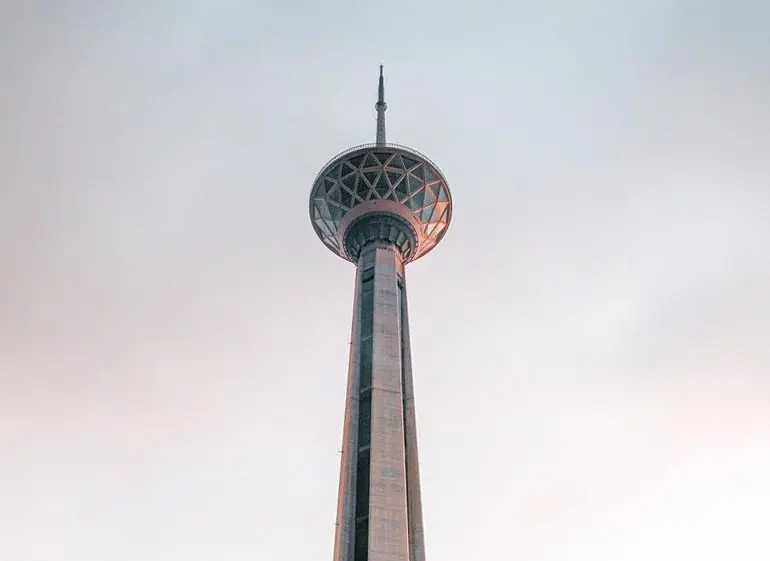
- Sa’dabad Complex
The Sa’dabad Complex is a sprawling 110-hectare royal complex in the Shemiran area of Tehran, originally built by the Qajar and Pahlavi monarchs. Today, it serves as a museum complex and cultural center, reflecting the history and art of Iran through its various palaces and the large expanse of lush gardens.
Overview of Sa’dabad Complex:
- Historical Background: The complex was first established under the Qajar dynasty but was extensively expanded and renovated during the Pahlavi era, specifically by Reza Shah and his son, Mohammad Reza Pahlavi. It was used as a summer residence by the Pahlavis and hosted many important diplomatic events.
- Palaces: The complex contains 18 palaces, which were used for various purposes by the royal family. Each building has its unique architectural style, with a blend of traditional Persian and modern 20th-century designs. Some of the notable palaces include:
- Green Palace (Shahvand Palace): Originally used as Reza Shah’s private residence, this palace is known for its exquisite green marble façade and elaborate interior decor, including a notable mirror hall.
- White Palace (Melat Palace): The largest of the palaces, it served as the official residence of Mohammad Reza Pahlavi. It houses furnishings and artifacts from the Pahlavi period and is a key exhibit for those interested in the life and times of the last Shah.
- Royal Automobile Museum: This museum displays an impressive collection of vintage cars and motorcycles used by the royal family.
- Museums and Cultural Institutions: Besides the palaces, the complex includes several museums that are dedicated to various aspects of Iranian and Western art. These include:
- Fine Arts Museum: Exhibiting a collection of Western and Iranian art including works by renowned artists.
- Museum of Royal Clothes: Showcasing the royal garments worn by members of the Pahlavi family.
- Museum of Natural History: Offers insight into Iran’s wildlife and includes a variety of taxidermied animals.
- Gardens and Natural Setting: The extensive grounds of the complex are covered with rich vegetation, including old trees, flower gardens, and water features making it a popular recreational spot for both locals and tourists.
- Cultural Events: The complex hosts various cultural events, exhibitions, and festivals throughout the year, making it an active center for cultural exchange and arts promotion in Tehran.
- Public Access and Educational Programs: Many of the palaces and museums within the complex are open to the public, offering guided tours that are informative for both historical enthusiasts and casual visitors. Educational programs are also conducted regularly for students and researchers.
The Sa’dabad Complex not only offers a glimpse into the opulent lifestyle of Iran’s former royal families but also serves as a significant cultural and historical landmark in Tehran, promoting Iranian arts and heritage. It provides an expansive and enriching experience for all visitors, combining art, history, and nature in one accessible location.
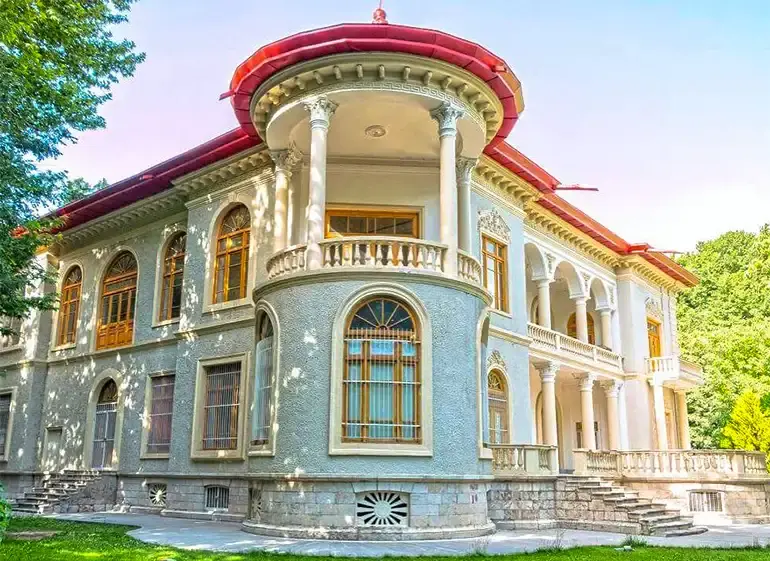
- Treasury of National Jewels
The Treasury of National Jewels, also known as the National Jewelry Museum, is located in Tehran, Iran, and is housed within the Central Bank of the Islamic Republic of Iran. This treasury holds one of the world’s most spectacular collections of jewels, including crowns, gem-studded swords and shields, aigrettes, necklaces, precious medals, and several other ornaments lavishly encrusted with diamonds, rubies, emeralds, and other precious stones.
- Historical Significance: The collection serves as a record of the lavish tastes of the Persian monarchs over the centuries. Many of these jewels were gifts from European and Asian dignitaries to the Persian court and have been preserved as part of the Iranian national heritage.
- The Imperial Crown Jewels of Iran: These include the crowns and tiaras worn by the Shahs and their consorts during the Qajar and Pahlavi dynasties.
- Darya-i-Noor Diamond: One of the largest pink diamonds in the world, this stunning gem is one of the most famous pieces in the collection.
- Peacock Throne (Takht-e Tavous): Originally built for the Mughal emperor of India, this throne was adorned with various precious stones and later acquired by Persian rulers.
- The Globe of Jewels: Crafted from gold and an array of gemstones, this globe features seas made from emeralds and land represented by rubies and diamonds.
- Security and Display: Due to the immense value and historical importance of these jewels, the collection is heavily guarded and exhibited under strict security conditions. The museum’s display is designed to enhance the visibility of intricate details on each piece, allowing visitors to appreciate the craftsmanship and artistry of ancient jewelers.
- Cultural Impact: The treasury not only showcases the opulence of Iran’s royal heritage but also reflects the craftsmanship and artistic achievements of Iran through the ages. It stands as a testament to the skills of Iranian jewelers and their ability to create intricate designs and work with precious materials.
- Educational Value: For those interested in the history of art, culture, and monarchy in Iran, the Treasury offers insightful perspectives through its guided tours. Educational programs and descriptions provide context about the significance of each piece in Iran’s history.
Visiting the Treasury of National Jewels provides a unique glimpse into the luxurious world of Persian royalty and offers a deep appreciation of the country’s rich history and cultural heritage. It is a must-visit for anyone interested in the art of jewelry making, the history of monarchy, or simply the beauty of precious stones.
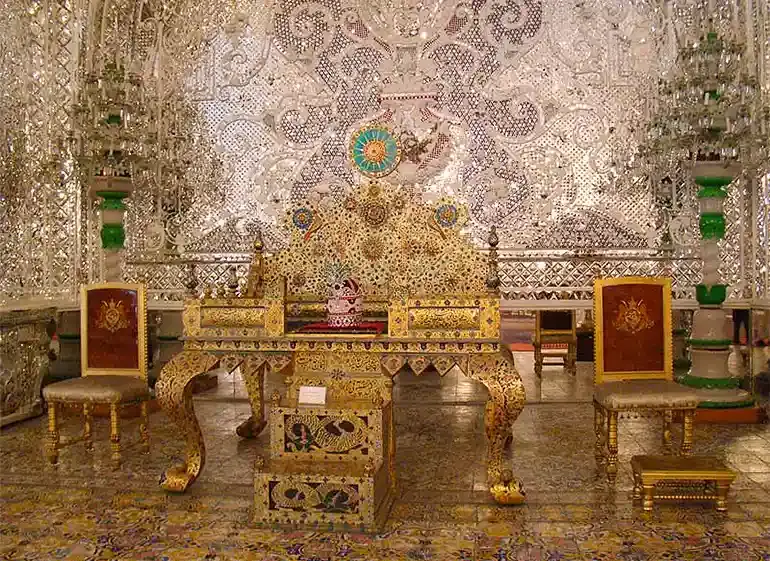
- Tehran Museum of Contemporary Art
The Tehran Museum of Contemporary Art, also known as TMoCA, is one of the most prominent cultural institutions in Iran, housing an impressive collection of both Western and Iranian modern and contemporary art. Opened in 1977, the museum is situated in Tehran’s Laleh Park and was designed by Iranian architect Kamran Diba, who drew inspiration from traditional Persian architecture, incorporating elements like wind catchers and reflecting pools in a modern context.
- Art Collection: TMoCA holds one of the most significant collections of modern art outside Europe and North America. The collection includes approximately 3,000 items featuring works by notable artists such as Pablo Picasso, Vincent van Gogh, Claude Monet, Andy Warhol, Jackson Pollock, and Mark Rothko. The museum also showcases a comprehensive collection of Iranian modern and contemporary artists.
- Architecture: The building itself is a piece of modern art with its spiral walkways and exterior facades designed to resemble traditional Persian architecture. The design creates a dialogue between the contemporary and the traditional, making the museum building itself a subject of admiration.
- Exhibitions and Programs: TMoCA hosts rotating exhibitions drawn from its collections and also features international exhibitions. The museum organizes various cultural events, including film screenings, artist talks, workshops, and educational programs, which actively engage the public and foster a deeper understanding of contemporary art.
- Conservation Efforts: The museum is also involved in conservation efforts, preserving both its Western and Iranian art pieces. These efforts ensure that the art survives in optimal condition for future generations to appreciate.
- Public Access and Engagement: The museum’s location in Laleh Park, one of Tehran’s largest public green spaces, makes it easily accessible and a popular cultural destination among both locals and tourists. Its active engagement through various programs makes it a center for artistic dialogue and cultural exchange.
- Impact on Cultural Scene: TMoCA significantly influences the cultural landscape of Tehran by bringing global art movements to Iran and promoting Iranian art on an international stage. It serves as a cultural bridge between Iran and the global art community.
Visiting the Tehran Museum of Contemporary Art provides an invaluable experience to explore an eclectic mix of art from Iran and around the world, making it a must-visit for art lovers and cultural enthusiasts traveling to Tehran.
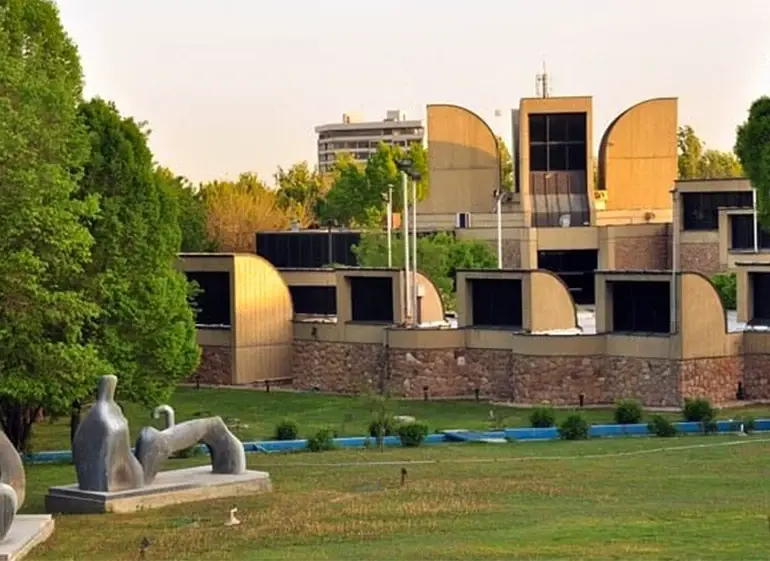
- Darband
Darband, an old village at the northern edge of Tehran, is now a popular recreational area that blends natural beauty with cultural charm, making it a favorite escape for both locals and tourists. Nestled in the foothills of the Alborz Mountains, Darband was originally a village on the outskirts of Tehran but has become integrated into the city as it expanded. The area is renowned for its cool climate, scenic landscapes, and vibrant social scene, particularly well-suited for hiking and leisure outings.
- Natural Setting: Darband is the starting point for trekking trails into the Alborz mountains, offering routes that vary in difficulty. The trails are lined with streams and waterfalls, providing a refreshing respite from the urban environment of Tehran.
- Social and Culinary Experience: As you ascend the paths of Darband, you’ll encounter numerous small cafes and traditional restaurants known as Sofreh Khaneh that serve a variety of Persian dishes, particularly kebabs and fresh local juices. These establishments often provide traditional seating on platforms with cushions, where guests can relax and enjoy the natural surroundings.
- Cultural Attractions: The area also features small shops selling local crafts, dried fruits, nuts, and herbal teas, which are popular among hikers and tourists. These shops add a cultural depth to the hiking experience, offering a taste of local products and traditions.
- Recreational Activities: Beyond dining and hiking, Darband is equipped with recreational facilities that include zip-lining and rock climbing, catering to adventure enthusiasts looking for a thrill in a natural setting.
- Accessibility: Darband is easily accessible from central Tehran, making it a convenient destination for a day trip. The area is particularly popular during weekends and holidays when many Tehran residents look for a quick escape from the hustle and bustle of city life.
- Evening Ambiance: In the evening, Darband transforms with the glow of lanterns and lights from the tea houses and restaurants, creating a cozy atmosphere that attracts those looking to enjoy Tehran’s cooler evening temperatures.
Visiting Darband offers a delightful blend of natural beauty, cultural immersion, and recreational activities, all within the backdrop of Tehran’s stunning mountainous landscape. It provides a refreshing contrast to the urban experience of the city and is a testament to Tehran’s diverse offerings.
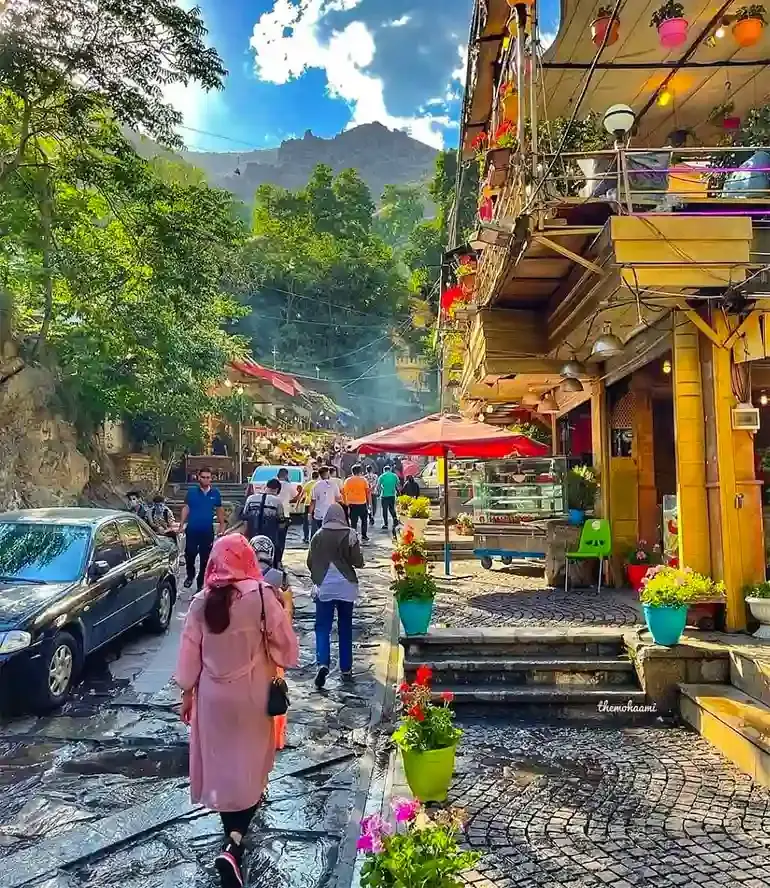
- City Theater
The City Theater of Tehran, also known as Tehran’s Municipal Theater, is a significant cultural landmark in the heart of the city. This theater complex, inaugurated in 1972, was designed by architect Ali Sardar Afkhami and showcases a blend of modern and traditional Persian architectural elements. It has become a focal point for performing arts in Iran, hosting a variety of theatrical productions, including plays, musicals, and experimental theater.
- Architectural Design: The City Theater complex features a distinctive façade that incorporates elements of traditional Persian architecture, such as brickwork and tile art, integrated into modern structural forms. The main building is especially notable for its round, tiered structure that resembles ancient amphitheaters, adapted for contemporary use.
- Main Stages and Halls: The complex includes several performance halls, with the main hall being the largest, accommodating audiences for a variety of performances. The other smaller halls are used for experimental and avant-garde productions, making the complex versatile in its offerings.
- Cultural Hub: The City Theater serves as a hub for the cultural life of Tehran, attracting not only theater enthusiasts but also performers and artists from various disciplines. It plays a crucial role in the development of Iranian theater and has been a launching pad for many of Iran’s most prominent playwrights and directors.
- Educational Role: The theater is also a center for educational activities related to the performing arts. It hosts workshops, seminars, and discussions that facilitate the exchange of ideas and nurture the next generation of Iranian theatrical talent.
- Artistic Exhibitions: Beyond theater, the complex often houses art exhibitions, literary readings, and other cultural events that contribute to the vibrant artistic atmosphere of the city.
- Accessibility: Located in the bustling area of Tehran, the theater is easily accessible to the public and is surrounded by other cultural institutions and urban amenities, enhancing its appeal as a cultural destination.
- Cultural Influence: The City Theater has had a profound influence on the cultural landscape of Tehran and Iran, promoting not only traditional Persian theater but also contemporary and international works, thereby enriching the cultural dialogue within the country.
Visiting the City Theater offers a deep dive into the dynamic world of Iranian performing arts and provides a window into the country’s rich cultural and artistic traditions. It remains one of the most important cultural venues in Tehran, celebrated for its architectural beauty and its significant contributions to the cultural life of the city.
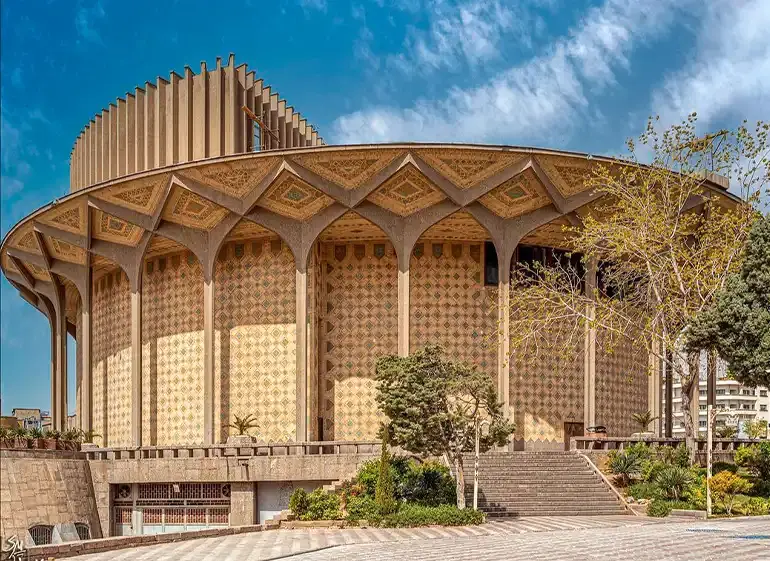
- Cinema Museum of Iran
The Cinema Museum of Iran, housed in the historic Ferdows Garden in Tehran, is dedicated to preserving and showcasing the rich history of Iranian cinema. This museum offers an extensive look at the film industry in Iran, from its inception in the early 20th century to its current status as a globally recognized powerhouse of creative cinematic expressions.
- Historic Venue: The museum is located in Ferdows Garden, a beautiful Qajar-era estate. The main building, which now houses the museum, was once a palace and has been restored to accommodate various exhibits and events. The setting adds a historical and aesthetic value to the museum, enhancing the visitor experience.
- Exhibitions and Collections: The Cinema Museum showcases a wide range of cinematic artifacts, including equipment used in early filmmaking, posters, scripts, photos, and promotional materials. The exhibits also cover significant periods and figures in Iranian cinema, providing a comprehensive overview of the industry’s development.
- Film Screenings and Festivals: The museum is not only about static displays; it actively participates in the film community by hosting regular screenings of both classic and contemporary films. It also hosts film festivals and special events that celebrate Iranian and international cinema, fostering cultural exchange and dialogue.
- Educational Programs: The museum offers educational workshops, seminars, and courses on various aspects of film production and history. These programs are designed to educate and inspire new filmmakers and enthusiasts, providing them with the tools and knowledge to appreciate or contribute to the art of cinema.
- Research and Preservation: The Cinema Museum also plays a crucial role in the preservation of Iranian cinematic heritage. It undertakes restoration projects to save deteriorating film stock and works to digitize archives to ensure that these cultural treasures are preserved for future generations.
- Interactive and Multimedia Exhibits: The museum embraces modern technology to create interactive exhibits that engage visitors more deeply with the content. Multimedia presentations and interactive stations help bring the history of Iranian cinema to life in engaging and informative ways.
- Cultural Impact: As a cultural institution, the Cinema Museum of Iran serves as a testament to the country’s dedication to cinema. It highlights the role of film as a medium of cultural expression and social commentary, reflecting the societal shifts and trends throughout Iran’s history.
Visiting the Cinema Museum of Iran provides a unique opportunity to explore the depth and diversity of Iranian cinema, offering insights into its past achievements and ongoing contributions to the global film industry. It is an essential destination for film lovers and anyone interested in the cultural narratives of Tehran.
- Artists Park (Park-e Honar Mandan)
Artists Park, also known as Park-e Honar Mandan, is a vibrant cultural hub located in Tehran, Iran. This park is a popular gathering spot for artists, intellectuals, and students, offering a unique blend of art, culture, and recreation in a serene park setting. It’s known for its laid-back atmosphere and as a space where creative ideas are freely exchanged.
- Cultural and Artistic Events: Artists Park regularly hosts a variety of cultural activities including art exhibitions, theater productions, and live music performances. These events attract a diverse crowd, from local artists and musicians to art lovers and tourists.
- Art Galleries and Workshops: The park is home to several art galleries that display works by both established and emerging Iranian artists. Workshops and classes are also frequently held, offering instruction in different art forms such as painting, sculpture, and photography.
- Cafes and Restaurants: The park features several cafes and restaurants that are popular among visitors. These establishments often have an artistic flair, with decor that reflects the creativity of the park. They provide a relaxing environment where people can discuss art and ideas over coffee or a meal.
- Green Spaces and Design: Artists Park is beautifully landscaped with plenty of green spaces, making it an ideal place for relaxation and inspiration. The design of the park encourages leisurely walks and impromptu outdoor gatherings, which are perfect for stimulating creativity and social interaction.
- Intellectual Environment: The park serves as a meeting point for intellectuals and thinkers, hosting discussions, literary readings, and poetry sessions. It’s a space where academia and arts converge, fostering an environment of learning and cultural exchange.
- Accessibility and Community Engagement: Easily accessible for locals and visitors alike, Artists Park is a vital part of the community. It’s not only a place for art but also a venue for public engagement and community events, contributing to the cultural life of Tehran.
- Cinema and Theater: The park includes a cinema and an open-air theater, which are venues for film screenings and live performances, further enhancing its reputation as a cultural center.
Visiting Artists Park offers a delightful experience where art and nature blend seamlessly. It’s a sanctuary in the bustling city of Tehran, providing a space for relaxation, creativity, and cultural immersion. This park is a testament to the vibrant artistic spirit of Tehran, making it a must-visit destination for anyone interested in the contemporary cultural scene of the city.
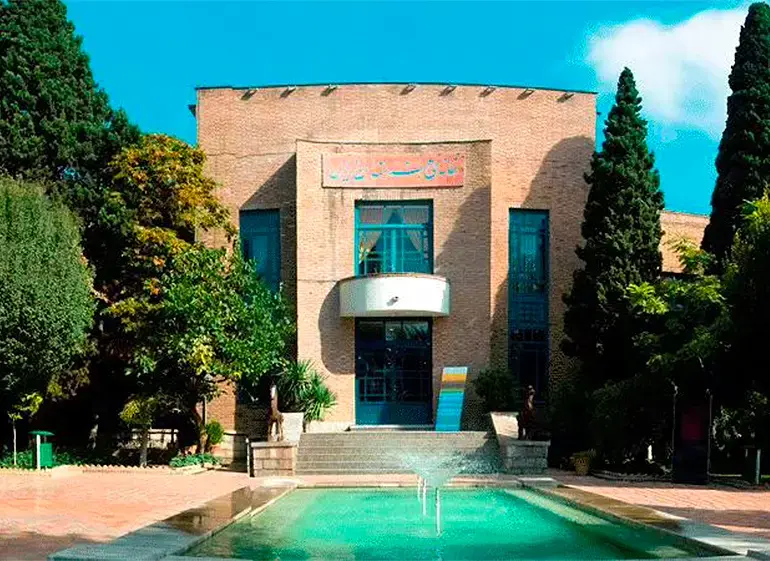
- Laleh Park
Laleh Park, one of Tehran’s large and popular parks, is located in the heart of the city, adjacent to several important cultural institutions such as the Tehran Museum of Contemporary Art and the Carpet Museum of Iran. Originally designed and constructed in the early 1960s, Laleh Park is known for its spacious lawns, variety of trees, and scenic walking paths, making it a favorite recreational spot for both locals and tourists.
- Cultural Proximity: Laleh Park’s location next to major museums enhances its cultural value, making it a common starting or ending point for visitors exploring Tehran’s art and history. Its proximity to these museums encourages a day full of cultural and outdoor activities.
- Recreational Facilities: The park is equipped with numerous recreational facilities including jogging tracks, playgrounds for children, and areas for sports like volleyball and soccer. It also has an outdoor gym and is a popular spot for morning exercises among residents.
- Green Space and Design: Laleh Park features a well-maintained landscape with a wide variety of trees and plants, some of which are labeled for educational purposes. The park’s design includes water features such as fountains and ponds, which add to the serene environment, ideal for relaxation and picnics.
- Art Installations and Sculptures: Scattered throughout the park are various sculptures and art installations, some by notable Iranian artists. These works add an artistic touch to the natural beauty of the park and serve as points of interest for visitors.
- Cultural Events: Laleh Park often hosts cultural events and festivals, especially during Nowruz (the Persian New Year) and other national holidays. These events can include crafts fairs, flower shows, and live music performances, contributing to the park’s vibrant atmosphere.
- Community Hub: The park serves as a community hub, attracting a diverse group of people. It’s a place where families gather, friends meet, and individuals come to seek a moment of peace away from the bustling city life.
- Accessibility: Easily accessible by public transportation and located near some of Tehran’s major thoroughfares, Laleh Park is conveniently located for anyone visiting the city.
Visiting Laleh Park provides a pleasant escape into nature with the added benefit of engaging in cultural activities due to its proximity to significant museums and cultural centers. It is an integral part of Tehran’s urban landscape, offering a peaceful yet vibrant setting for relaxation and cultural immersion.
- Carpet Museum of Iran
The Carpet Museum of Iran, located in Tehran near Laleh Park, is dedicated to the art and history of carpet weaving, which is one of the most distinguished manifestations of Persian culture and art. Opened in 1976, the museum was designed by the last queen of Iran, Farah Diba Pahlavi, and features an exterior that resembles a carpet loom.
- Extensive Collection: The museum houses an impressive collection of Persian carpets from all over the country, dating back to the 16th century to the present. The collection includes over 700 pieces, showcasing a variety of styles, patterns, and weaving techniques that illustrate the diversity and richness of Iranian carpet art.
- Exhibition Space: The museum’s display area is split into two floors. The ground floor exhibits permanent collections of antique and valuable Persian carpets, while the upper floor hosts temporary exhibitions on specific themes or new research findings related to Persian carpets.
- Educational Programs: The Carpet Museum of Iran offers educational and research resources, including a library rich with books on the art of carpet weaving. These resources are invaluable for researchers, students, and anyone interested in understanding more about the historical and cultural context of Persian carpets.
- Cultural Significance: Each carpet in the museum tells a story, reflecting the traditions, beliefs, and social history of the region from which it came. The museum not only celebrates the artistic achievement of carpet weaving but also its role in the cultural and social fabric of Iran.
- Architectural Design: The building itself is notable for its unique architecture inspired by carpet weaving looms, which are both symbolic and functional, providing an ideal space for displaying intricate and colorful carpet designs.
- Interactive Displays: Some exhibits are interactive, offering visitors insights into the materials, techniques, and dyes used in carpet weaving. This hands-on approach helps to engage visitors and gives them a deeper appreciation of the craftsmanship involved in creating Persian carpets.
- Gift Shop: The museum features a gift shop where visitors can purchase books, replicas of traditional carpets, and other carpet-related souvenirs.
Visiting the Carpet Museum of Iran provides a deep dive into one of Iran’s most iconic arts. It is an enlightening experience for anyone interested in the artistic, cultural, and historical aspects of Persian carpets, offering a comprehensive look at this significant element of Iranian heritage.
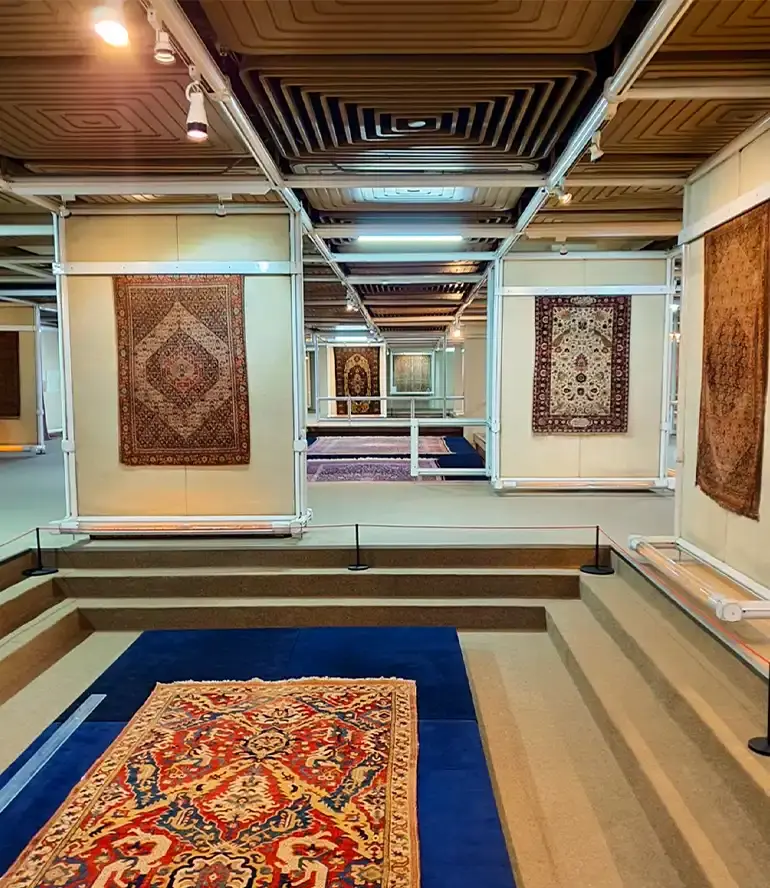
- Iranian Artists Forum
The Iranian Artists Forum is a dynamic cultural and artistic space located in the heart of Tehran, in the Artists Park. It serves as a central hub for the artistic community, offering a platform for dialogue, collaboration, and public engagement in the arts. The Forum plays a pivotal role in promoting contemporary Iranian art and culture, providing support and visibility for artists across various disciplines.
- Diverse Facilities: The Forum includes multiple galleries, theaters, a cinema, and classrooms. These spaces host a wide range of activities including art exhibitions, film screenings, theatrical performances, workshops, and educational programs.
- Art Exhibitions: The galleries at the Forum showcase works from emerging and established Iranian artists, offering them a prestigious venue to present their art. The exhibitions vary from traditional to modern and contemporary art, reflecting the rich tapestry of Iranian artistic expression.
- Performances and Screenings: The theaters and cinema on site are active with regular performances and film screenings that cater to diverse tastes. These range from experimental theater to mainstream cinema, providing a comprehensive overview of Iran’s vibrant performing arts scene.
- Educational Programs: The Forum conducts workshops, seminars, and classes that are open to both professional artists and the general public. These programs cover a broad spectrum of artistic fields including painting, sculpture, photography, cinema, and theater, facilitating ongoing education and skill development in the arts.
- Cultural Events: The Iranian Artists Forum is known for hosting significant cultural events such as book fairs, music festivals, and poetry nights, which attract a large audience of art lovers and cultural enthusiasts.
- Community Engagement: As a central gathering place for artists and intellectuals, the Forum fosters a sense of community and collaboration among the creative sectors in Tehran. It serves as a meeting point for exchanging ideas and inspiring new artistic projects.
- Café and Social Spaces: The venue also includes a café and other social spaces where artists and visitors can mingle, discuss their work, and network in a relaxed atmosphere.
Visiting the Iranian Artists Forum offers a unique opportunity to immerse oneself in the contemporary cultural scene of Tehran. It is an essential destination for anyone interested in the arts, providing insight into the thriving and diverse artistic community of Iran.
Last word
Tehran, a city where history and contemporary culture converge, offers a wealth of cultural attractions that are as diverse as they are compelling. From the stunning architecture and royal treasures of the Golestan Palace to the bustling corridors of the Tehran Grand Bazaar, the city offers a unique glimpse into the rich tapestry of Persian history and modernity. Museums like the National Museum of Iran and the Tehran Museum of Contemporary Art provide deep dives into ancient civilizations and vibrant modern art scenes, respectively.
For those seeking a serene escape amidst the urban landscape, Laleh Park and the lush environs of the Sa’dabad Complex offer peaceful retreats with added historical and artistic value. Meanwhile, the Iranian Artists Forum and Darband provide lively cultural exchanges and artistic inspiration in settings that encourage social interaction and creative expression.
Each site in Tehran tells a part of the story of Iran’s cultural evolution, making the city a must-visit for anyone interested in exploring the depths of historical riches and contemporary artistic endeavors. Whether you are an art aficionado, a history enthusiast, or simply in search of a vibrant cultural experience, Tehran’s array of cultural attractions offers a profound and enriching journey through the heart of Iran.
